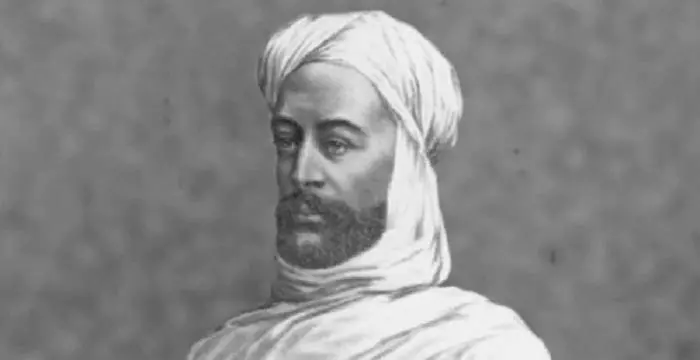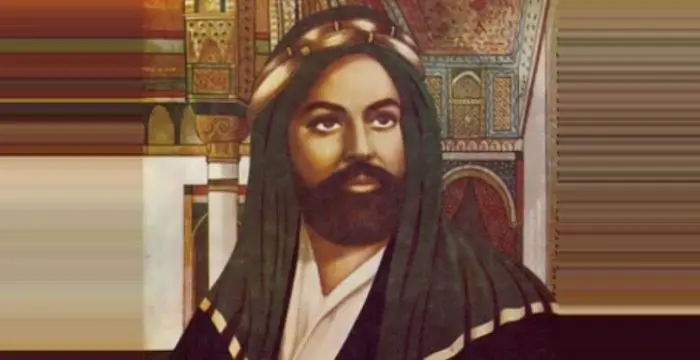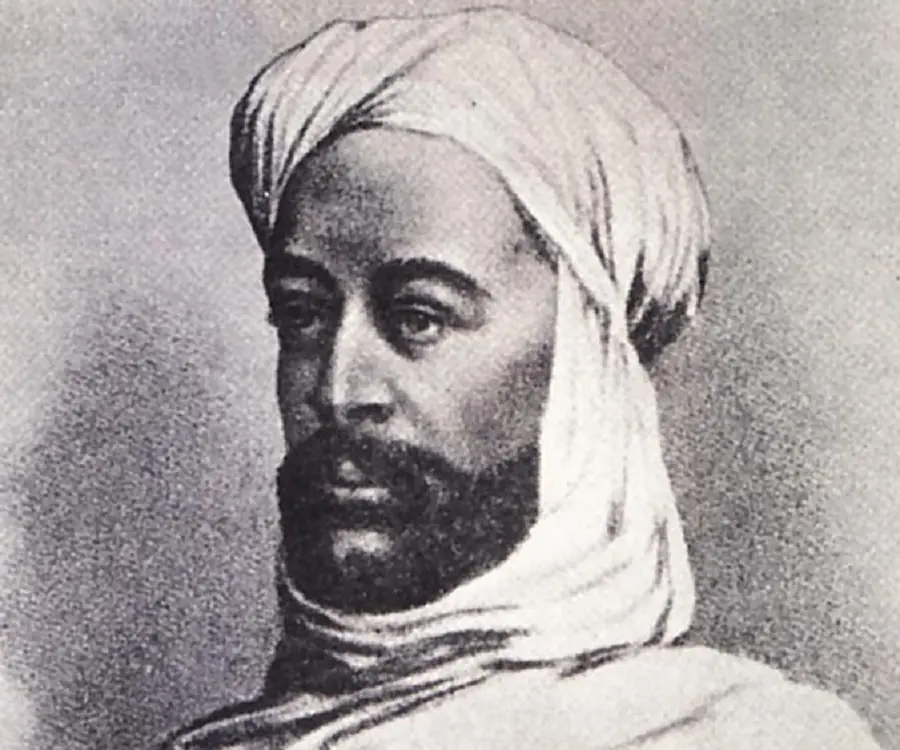
Muhammad Ahmad - Spiritual, Life Achievements and Family
Muhammad Ahmad's Personal Details
Muhammad Ahmad was a Sudanese religious leader, who claimed to be deliverer of evil, the ‘Mahdi’, and led a successful ‘jihad’ movement
| Information | Detail |
|---|---|
| Birthday | August 12, 1844 |
| Died on | June 22, 1885 |
| Nationality | Sudanese |
| Famous | Leaders, Spiritual & Religious Leaders, Religious Leaders, Spiritual |
| Birth Place | Dongola |
| Religion | Islam |
| Gender | Male |
| Sun Sign | Leo |
| Born in | Dongola |
| Famous as | Religious Leader |
| Died at Age | 40 |
// Famous Spiritual
Prophet Muhammad
Prophet Muhammad was the founder of Islam, one of the most widespread religions in the world. This biography profiles his childhood, life story, achievements and more.
Murad IV
Murad IV was one of the mighty Sultans in the history of the Ottoman Empire. This biography profiles his childhood, family, accession, rule, administration and timeline.
Eckhart Tolle
Eckhart Tolle is a well-known spiritual leader, and author. Check out this biography to know about his childhood, family, personal life, spiritual awakening, etc.
Muhammad Ahmad's photo
Who is Muhammad Ahmad?
Muhammad Ahmad, the son of a boat builder, showed an interest towards religious studies, unlike his siblings. Taught by some of the finest spiritual teachers in Sudan, his love for Islam, particularly 'Samaniyya Sufism’, grew. To feed this passion for religion, he asked Sheikh Muhammad Sharif Nur al-Dai'm to be his teacher. After learning about Islam, the young boy began his life as a religious teacher himself. People in Aba Island, where he taught the 'Quran', became fond of him. This caused dissension between his followers and the disciples of Sheikh Sharif. When both spiritual leaders had a fall-out owing to their differences, Ahmad approached another leader, Sheikh al-Qurashi. With al-Qurashi's death, the young leader grew even more powerful, and declared himself the 'Mahdi', or the redeemer of Islam. While some believed him and hailed him as the "Successor of the Messenger of God", most conservative practitioners of Islam snubbed him, and instigated Egyptian authorities to take him into custody. By that time, however, he had created a huge army of followers, known as ‘Ansar’, and after battling for years, they emerged victorious, ultimately controlling the whole of Sudan. After his death, the movement was carried on by his disciple Abdallahi ibn Muhammad, who came to be known as ‘Khalifa’
// Famous Religious Leaders
Prophet Muhammad
Prophet Muhammad was the founder of Islam, one of the most widespread religions in the world. This biography profiles his childhood, life story, achievements and more.
Murad IV
Murad IV was one of the mighty Sultans in the history of the Ottoman Empire. This biography profiles his childhood, family, accession, rule, administration and timeline.
Eckhart Tolle
Eckhart Tolle is a well-known spiritual leader, and author. Check out this biography to know about his childhood, family, personal life, spiritual awakening, etc.
Childhood & Early Life
Muhammad Ahmad was born to a boat builder, Abdullah, and his wife in Labab Island-Dongola, Northern Sudan, on August 12, 1845.
A few years later, Abdullah settled down in Karari, a town lying to the north of Omdurman, the largest city of Sudan.
The young child was inclined towards Islamic theology, and was taught by the likes of Sheikh al-Amin al-Suwaylih and Sheikh Muhammad al-Dikayr 'Abdallah Khujali, both renowned religious teachers in Sudan.
Deeply influenced by the teachings of Islam, Ahmad visited Sheikh Muhammad Sharif Nur al-Dai'm, who was a major proponent of the ‘Samaniyya’ Sufi order in Sudan. From 1861-68, the adolescent boy lived with Sharif, mastered the nuances of his religion, and was subsequently honoured with the title of ‘Sheikh’.
Career
After receiving the title of 'Sheikh', Muhammad became a teacher and was allowed to give spiritual education, also known as 'tariqa', to new members of the sect.
In 1870, Ahmad's family moved to Aba Island, south of Khartoum, and here, the young man constructed a mosque so he could teach the 'Quran'. He gained popularity amongst his students for the way he taught, and for his loyalty to the holy book.
Two years later, in 1872, Sheikh Sharif was invited by Muhammad to live in the al-Aradayb region, close to Aba Island. For some time, the two religious leaders fostered a friendly relationship, but eventually their differences began to surface.
In 1878, Sharif started disliking the adulation that his former student was receiving, leading to a violent altercation between the followers of both the teachers. Though the conflict was temporarily sorted out, they had a second contention, which caused Sharif to oust Ahmad from the ‘Samaniyya’ sect.
Post this dissension, the expelled leader, along with his followers, requested rival ‘Samaniyya’ teacher Sheikh al-Qurashi wad al-Zayn to accept him as his follower, and the latter readily obliged. The same year, al-Qurashi died and Muhammad was made the new leader of the order, during which he met his successor, Abdallahi bin Muhammad al-Ta'aishi.
On June 29, the 'Samaniyya' leader declared himself to be the 'Mahdi', which means the prophet of Islam, who would redeem the religious order and deliver the world from evil. He claimed to have been chosen as the 'Mahdi' by a 'hadra', or an assembly of all prophets beginning from Adam to Muhammad.
The spiritual teacher drew several comparisons to prove that he was a divine manifestation of the Messenger of God. He also named the followers of his sect as 'Ansar', so as to differentiate them from practitioners of other forms of Sufism.
Though he was extremely popular amongst followers of 'Samaniyya', the conservative Islamic leaders, known as the 'Ulema', including teachers like Mufti Shakir al-Ghazi and Qadi Ahmad al-Azhari, derided his claims.
Despite controversies, Muhammad continued to spread his doctrines, obliterating the four Sunni orders of Islam. He also redrafted the declaration of faith, known as the 'Shahada', inserting the new phrase, "Muhammad al-Mahdi is the Khalifa of the Prophet of God".
The Egyptian government decided to arrest the 'Mahdi', after discussing the matter with the 'Ulema' orthodox leaders. However, the 'Samaniyya' leader's disciples defeated the army of 200 Egyptian soldiers in the 'Battle of Aba'.
The 'Mahdi' declared 'jihad', a resistance movement against the Turks, ordering his followers to annihilate any Turk who crossed paths with them. This move was considered blasphemy by orthodox Muslims, but Ahmad travelled to the province of Kurdufan in Central Sudan, accompanied by his disciples.
In Kurdufan, he built an army made up of members of the 'Baqqara', 'Rizeigat', 'Hadendoa Beja' and 'Ta'aisha' ethnic tribes. The army included prominent leaders like Sheikh Madibbo ibn Ali, Osman Digna and Abdallahi ibn Muhammad.
The 'jihad' movement also gained popularity with the Nuer, Bahr Alghazal, Shilluk and Anuak ethnic races of Southern Sudan, giving the revolt nation-wide importance. The army of 'jihadis' started their protest by launching an attack against the orthodox Khatmiyya religious order in Kassala, eastern Sudan.
In 1883, the followers seized an Egyptian army of 4000 soldiers near El Obeid in Kurdufan, using nothing but swords and spears. Post this invasion, they emerged victorious in the 'Battle of El Obeid', against an Anglo-Egyptian army of 8000 soldiers led by British Colonel William Hicks, also called Hicks Pasha.
Following the two wars in El Obeid, western Sudan was completely taken over by Muhammad. They continued their rampage in the Suakin port, but was defeated in the ‘Battle of El Teb’, led by General Gerald Graham.
In December 1883, British officer Charles George Gordon, also known as Gordon of Khartoum, was given the responsibility of clearing the soldiers from most of Sudan. Gordon arrived in February, the following year, and apprehending trouble in his mission, prepared for a fight against the 'Ansar'.
For almost a year, the British forces were able to hold back the 'Ansar' army, but when Gordon reached Khartoum his infantry witnessed the invasion of the city by the 'Mahdists', in the 'Battle of Khartoum'.
The insurgents found their way to Gordon's garrison and he was killed, his body slashed, and his head cut off. Gordon's comrade, Lord Garnet Joseph Wolseley, had to flee with his soldiers after being attacked by the 'Mahdists'.
Muhammad's army continued to capture towns of Sudan, including Sannar and Kassala. Having gained control over most of Sudan, the self-declared 'Mahdi' established a new government, by reforming the whole Islamic law, known as 'Shariah'. He also ordered other religious books to be burnt, since they allowed different sects to co-exist.
Major Works
Ahmad, the religious teacher is famous for having led his ‘Samaniyya’ disciples in a long-drawn battle against the Turks and leaders of orthodox Islamic orders, thus establishing his rule in Sudan.
Personal Life & Legacy
On June 22, 1885, the 'Mahdi' succumbed to a bacterial disease known as typhus and was entombed in Omdurman, close to Khartoum. Three deputies were chosen by the religious teacher, to lead his followers, of who Abdallahi ibn Muhammad soon became the sole leader.
The movement was carried on after Abdallahi, also known as 'Khalifa', by Ahmad's son Abd al-Rahman al-Mahdi. More recently, Imam Sadiq al-Mahdi, the great-great-grandson of Muhammad, is the leader of the Sudanese 'National Umma Party'.
Trivia
On gaining control of Sudan, this religious leader replaced the ‘hajj’ (holy pilgrimage) to Mecca, with ‘jihad’ (struggle), as one of the most important duties of a devout Muslim
// Famous Leaders
Edi Rama
Edi Rama is the current Prime Minister of Albania. Check out this biography to know about his childhood, life, achievements, works & timeline.
Tecumseh
Tecumseh was a Native American leader of the Shawnee clan. This biography profiles his childhood, life and timeline.
Khalifa bin Zayed Al Nahyan
Sheikh Khalifa bin Zayed Al Nahyan is the current President of the United Arab Emirates (UAE). Check out this biography to know about his birthday, childhood, family life, achievements and fun facts about him.
Muhammad Ahmad biography timelines
- // 12th Aug 1845Muhammad Ahmad was born to a boat builder, Abdullah, and his wife in Labab Island-Dongola, Northern Sudan, on August 12, 1845.
- // 1861 To 1868Deeply influenced by the teachings of Islam, Ahmad visited Sheikh Muhammad Sharif Nur al-Dai'm, who was a major proponent of the ‘Samaniyya’ Sufi order in Sudan. From 1861-68, the adolescent boy lived with Sharif, mastered the nuances of his religion, and was subsequently honoured with the title of ‘Sheikh’.
- // 1870In 1870, Ahmad's family moved to Aba Island, south of Khartoum, and here, the young man constructed a mosque so he could teach the 'Quran'. He gained popularity amongst his students for the way he taught, and for his loyalty to the holy book.
- // 1872Two years later, in 1872, Sheikh Sharif was invited by Muhammad to live in the al-Aradayb region, close to Aba Island. For some time, the two religious leaders fostered a friendly relationship, but eventually their differences began to surface.
- // 1878In 1878, Sharif started disliking the adulation that his former student was receiving, leading to a violent altercation between the followers of both the teachers. Though the conflict was temporarily sorted out, they had a second contention, which caused Sharif to oust Ahmad from the ‘Samaniyya’ sect.
- // 1883In 1883, the followers seized an Egyptian army of 4000 soldiers near El Obeid in Kurdufan, using nothing but swords and spears. Post this invasion, they emerged victorious in the 'Battle of El Obeid', against an Anglo-Egyptian army of 8000 soldiers led by British Colonel William Hicks, also called Hicks Pasha.
- // Dec 1883In December 1883, British officer Charles George Gordon, also known as Gordon of Khartoum, was given the responsibility of clearing the soldiers from most of Sudan. Gordon arrived in February, the following year, and apprehending trouble in his mission, prepared for a fight against the 'Ansar'.
- // 22nd Jun 1885On June 22, 1885, the 'Mahdi' succumbed to a bacterial disease known as typhus and was entombed in Omdurman, close to Khartoum. Three deputies were chosen by the religious teacher, to lead his followers, of who Abdallahi ibn Muhammad soon became the sole leader.
// Famous Spiritual & Religious Leaders
Swami Vivekananda
Swami Vivekananda was the chief disciple of Sri Ramakrishna, and was responsible for awakening India spiritually. Check this biography to know in detail about his life, profile and timeline.
Prophet Muhammad
Prophet Muhammad was the founder of Islam, one of the most widespread religions in the world. This biography profiles his childhood, life story, achievements and more.
Murad IV
Murad IV was one of the mighty Sultans in the history of the Ottoman Empire. This biography profiles his childhood, family, accession, rule, administration and timeline.
Eckhart Tolle
Eckhart Tolle is a well-known spiritual leader, and author. Check out this biography to know about his childhood, family, personal life, spiritual awakening, etc.
Russell M. Nelson
Russell M. Nelson is an American religious leader, author, and philanthropist. Check out this biography to know about his birthday, childhood, family life, achievements and fun facts about him.
Gautama Buddha
Gautama Buddha was a spiritual leader on whose teachings Buddhism was founded. This biography of Gautama Buddha provides detailed information about his childhood, life, achievements, works & timeline
Muhammad Ahmad's FAQ
What is Muhammad Ahmad birthday?
Muhammad Ahmad was born at 1844-08-12
When was Muhammad Ahmad died?
Muhammad Ahmad was died at 1885-06-22
Where was Muhammad Ahmad died?
Muhammad Ahmad was died in Khartoum
Which age was Muhammad Ahmad died?
Muhammad Ahmad was died at age 40
Where is Muhammad Ahmad's birth place?
Muhammad Ahmad was born in Dongola
What is Muhammad Ahmad nationalities?
Muhammad Ahmad's nationalities is Sudanese
What is Muhammad Ahmad's religion?
Muhammad Ahmad's religion is Islam
What is Muhammad Ahmad's sun sign?
Muhammad Ahmad is Leo
How famous is Muhammad Ahmad?
Muhammad Ahmad is famouse as Religious Leader









